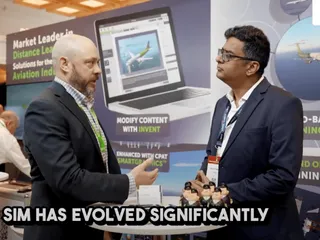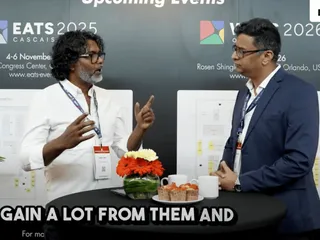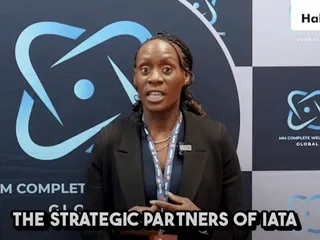SESAM 2019 gives audiences new training perspectives
Contact Our Team
For more information about how Halldale can add value to your marketing and promotional campaigns or to discuss event exhibitor and sponsorship opportunities, contact our team to find out more
The Americas -
holly.foster@halldale.com
Rest of World -
jeremy@halldale.com

Written by Judith Riess, MTM editor-in-chief
SESAM 2019, which was held in Glasgow, Scotland, at Glasgow Caledonian University from 12-14 June 2019, marked the Society for Simulation in Europe’s 25th year. This year’s theme “Excelling Together - 25 Years of Interprofessional Simulation in Europe" had exciting keynote addresses from across the globe as well as enlightening breakout sessions and workshops, and showcased new technologies with the vendors and the poster sessions.
The keynote addresses were very differentbut made the audience look at education and training from a differentperspective. Keynotes were delivered by experts in their field who were notnecessarily in medicine. As an example, the last day’s keynote was given by ChristopherHampson, CEO/ artistic director of the Scottish Ballet. He gave us a brief historyof ballet and talked about his years of training and the years of disciplinedpractice it took from the time he went to Royal Ballet’s boarding school at theage of 11 to the time he become proficient. He said they all faced rigorousdiscipline and brutal candor from their instructors through hours of practice,but they learned resilience and self-awareness. However, he assured us, that‘practice’ does not make perfect. There is no such thing, in his opinion, butis what everyone continues to strive for. In his mind to be a great ‘anything’ weneed to be willing to experiment with vigor, maintain individualaccountability, accept and grow from criticism, and if something does not work,move on. Two of his troops gave an outstanding performance where the femalenever touched the ground. His message to us was to ‘trust’ and empowerindividuals. She had perfect trust that her partner would never allow any partof her body to touch the ground. How many of us have complete trust or faith inourselves or in our colleagues? He parted with ‘leaders must be accountable andlead with authenticity and purpose’.
KTWaxman, stressing the importance of team training, talked about her fear whenshe first became a nurse and how she had no background to deal with her firstCode Blue within six months of becoming a nurse. She described how much itwould have meant to her to be able to practice in a lab before she experiencedit in the hospital. Waxman urged members of the audience to become catalystsfor interprofessional education (IPE) in their institutions and highlighted theimportance of breaking down silos. “Working in silos does not improvehealthcare, and you do not work that way in real life,” she said. Sheencouraged the audience to be leaders and to work to make IPE unnecessary because,and she quoted Lou Halamek, who was in the audience, “IPE will disappearbecause it will just be what we do”. Dr. Waxman is the president of IMSH andthe director of the California Simulation Alliance. Waxman has grown theCalifornia Simulation Alliance to a collaborative interprofessional network of65 hospitals and 35 nursing groups. She encouraged the audience to buildrelationships and challenge others to not just ‘talk the talk’ but ‘walk thewalk’ to improve health outcomes and patient safety.
The Lou Oberndorf Keynote Lecture was given by Jessica Mesman, associate professor at the Department of Technology and Society Studies at Maastricht University, who is also affiliated with Mayo in Rochester, MN, USA. Her presentation focused on looking at critical care from a different perspective and looking at medicine in action and questioning why things go well or poorly but focusing on the ‘well’. Her method of video-reflexivity in critical care medicine, particularly the exnovation (an often overlooked part of the innovation process which in combination defines an innovation life-cycle of informal and unarticulated dimensions of establishing and preserving safety in health care practices), while visualizing healthcare practice improvement. The video showcases what goes well, and she suggests we should redesign and visualize a different improved system. She also cautioned that it is not easy but can have a dramatic effect on our system of care.
Theworkshops covered a range of practices from faculty development to best practicesin standardized patient methodology. The standardized patient workshops coveredhow-to’s ranging from enriching simulation with standardized patients toenhancing standardized patient OSCE stations through improvement of techniquesthrough simulation. As usual, there were many workshops and sessions, and we hadto pick and choose carefully the ones we felt were of the most value, as we couldnot possibly attend but one session at a time. Fortunately, they were wellattended and the ones that I observed generated lively discussions and manyquestions.
Sessionsincluded Patient Safety and Quality Improvement, How to impart Bad News toMental Health Issues, to highlight a few. Other sessions dealt with debriefing,conducting research, and faculty development, and there were two workshops by vendorsiRIS and CAE.
They had all the poster sessions up and you simply clicked on the symbol, which downloaded the article to your phone, and you could go through the articles at your leisure. It was sponsored by LEARNING TOOLBOX and Kubify and made it easy to read the poster sessions at your leisure and not miss sessions.
Dr. DavidGrant and his team put on an excellent conference, and next year’s SESAM 2020will be held in Milan, Italy, from June 17-19 at the Milan Convention Center. Theyare already in discussion and are talking about enhancements and possible livesimulations from the three surrounding simulation centres, which should prove tobe an interesting and rewarding conference.


